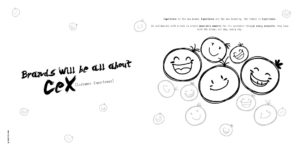Time to Re Imagine Business! And the time is now. As they say, ” The future is already here, but it is a tad unevenly distributed ‘.
It’s a new world of business. So, isn’t it time to ring out the old and bring in the new? A new mandate has to enter the fray.
Can we shake free of the past? Including(yes definitely) past successes! Can we re imagine an entirely new way of doing business?
Could we stop using these two traditional phrases( I will tell you why):
” Push the envelope “
” Think outside the box “
The problem with both the above(other than their gross overuse) is:
Both suggest that there is an intact envelope or a sturdy box from whose known (and identified borders) we can step out from. But remember:
The envelope is already torn and crumpled..and
The box has been run over by a speeding trailer truck.
So, the task at hand is to:
Think “Weird“, however weird it may sound..be wired for it!
(Re)think ” excellence “
Re-Imagine ” leadership “
Get strange. Did you know that the No 1 source of innovation is ‘ pissed off ‘ people ? People who just cannot tolerate the mundane, the silly, the mediocre that is happening around them. That’s the origin of the best innovation you can ever lay your hands on. So, go ahead and seek pissed off people! HR, are you listening?
Fire the planners. Hire the freaks.
An “excessive cult of the consumer“- ” customer driven” also means being slave to demographics, market research and focus groups. So, ‘listening to customers ‘ might just be the No 1 sin in marketing...
Turn the cliched phrase on its head. ‘The customer is always right‘ to ‘ The customer is always late ‘-
Who wanted Post It Notes? Nobody for a dozen years till 3M ‘ wrote ‘ history and we still keep ‘posting’.
Who wanted Fax Machines? Nobody for the longest time till a ‘ critical mass ‘ of users came along.
Who wanted CDs? Nobody or atleast none of us who had just been through the transformation from phonograph records to tapes. Then the kids started using CDs and the awesome quality of sound made us go Ka-boom!
In the words of Doug Atkin, a partner at Merkley Newman Harty: ” These days you can’t succeed as a company if you’re consumer led-because in a world of constant change, consumers can’t anticipate the next big thing. Companies should be idea-led and consumer-informed”
It’s time to re-imagine. At ISD Global we are constantly trying to be as future ready as possible, driven by the weird, motivated by the untried and fuelled by no fear. To generate ideas that can transform businesses and thereby quality of human life.
Your time starts now. The clock is ticking!
ENDS
www.brandknewmag.com
www.groupisd.com/story

